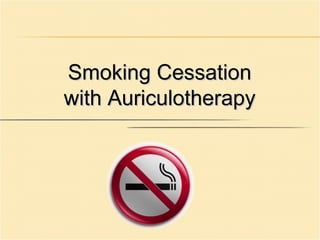
Smoking Cessation with Auriculotherapy
- 2. “Nothing is easier than stopping smoking. I’ve given it up twenty times in the past five years.”
- 3. Treatment will likely pay for itself in a month or less just in cigarette costs—not to mention improved health and longer life! 20 minutes: Blood pressure and pulse rate drop to normal. 8 hours: Carbon monoxide level in the blood drops to normal and oxygen levels increase to normal. 24 hours: Chance of heart attack and stroke decreases. 48 hours: Nerve endings begin to re-grow and the ability to taste and smell is enhanced.
- 4. 2 weeks to 3 months: Circulation improves, and lung function increases up to 30% 1-9 Months: Coughing, sinus congestion, fatigue, and shortness of breath decreases. Cilia begin to re-grow in the lungs, increasing the body’s ability to handle mucus and clean the lungs to reduce infection. The body’s overall energy is increased. 1 year: Excess risk of coronary heart disease is half of that of a smoker. 5 years: Lung cancer death rate for average former smokers decreases by almost half. Risk of stroke is reduced to that of a nonsmoker. The risk of cancer of the mouth, throat, and esophagus is half of that of a smoker.
- 5. But do you know why it is so hard to QUIT?
- 6. Nicotine stimulates the Central Nervous System and releases dopamine to the brain. Dopamine produces the feelings of relaxation and well being associated with smoking. This leads to physical dependence as the brain adjusts to the increasing dopamine levels by down-regulating dopamine receptors.
- 7. Thesmoker becomes dependent on the dopamine high to regulate emotional responses and provide pleasant feelings. This is why smokers become moody and irritable when they can’t smoke.
- 8. Habit forming in certain situations… Driving Eating Taking a break at work *Such situations will trigger a psychological craving for a cigarette.
- 9. Auriculotherapy is VERY effective in helping smokers quit. Success rate of 75-86%.
- 10. Auriculotherapy affects the dopamine pathways in the brain Reduces cravings Helpsthe brain reestablish normal dopamine levels— WITHOUT nicotine!
- 11. Emotional stability returns The patient begins to feel more in control Psychological habits are broken Oldtrigger situations will no longer trigger cigarette cravings
- 12. The half-life of nicotine in the blood is 2 hours, and within 72 hours of the last cigarette, nearly all nicotine has been eliminated from the body. This is why cravings generally peak around the third day of quitting, and rapidly decline thereafter.
- 13. Auricular therapy treatment may be performed in a variety of ways: Small electrical current Laser light Ear seeds Tiny needles
- 14. The patient needs to be ready—no more cigarettes EVER! (This isn’t a REDUCE smoking program. This is a QUIT smoking program!) Quitting day should be early in the week. (NOT over a weekend) Dispose of all cigarettes. Commit to daily treatment for the first 3-5 days. Don’t skip meals—especially breakfast. Vitamin C supplements for a minimum of 2 weeks.
- 15. 2-4 weeks of treatment 10-20 minutes of auricular therapy per visit A tiny sensation in the ear where the point is being treated Huge decrease in nicotine withdrawal symptoms Tools for self-treatment between scheduled visits
- 16. Cravings may still come, but they will NEVER last longer than 3-5 minutes and the average smoker experiences only about 6 cravings per day by the 3rd day. Find something else to do during those 3-5 minute cravings. If you can last 3-5 minutes—you can beat smoking!
- 17. Overcome your addiction. Increased energy. Better overall health. Perform at your maximum potential.
- 18. Here’s to Your Success!